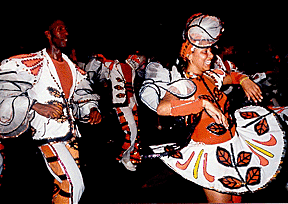Mardi Gras in Veracruz–called Carnaval in
Mexico–is the holiday celebrated as a festival of the libido before
the Catholic period of Lent. Beginning every year nine days before Lent,
Carnaval is exuberantly enjoyed with parades, floats, costumes, music,
dancing, and all-night partying. The city of Veracruz virtually shuts
down during the event as thousands of visitors from throughout Mexico
descend on it to join the festivities. Visitors pack the streets and
hotels, those without rooms live out of their cars.
Though many centuries old, the idea of parades
during Carnaval began in 1866, during the reign of Emperor Maxmillian.
Carnaval, as it exists today, has been held without interruption since
1923.
Origins of Carnival
Veracruz Carnaval, like many of its fellow
Latin American Carnavals, has merged church, state and the collective
will of the people into unique annual traditions that preserve the past
while looking forward to the future. Five hundred years ago, the
Venetians demonstrated how this could be done within the constraints of
church oversight. They invented the word Carnevale–from the Latin
roots carne meaning flesh and valle meaning farewell.
Veracruz’s Carnaval has a soul as old as the Olmecs and as new as the
flowers sold by the Indian women in the Verazruz’s Plaza de Armas–or
as it is commonly known, the zocalo.
Anticipation builds in the days before Carnaval
as Jarochos make preparations for the important Zocalo opening ceremony Quema
del Mal Humor or The Burning of Bad Humor in which there’s an
enthusiastic pursuit, persecution and burning of the satanic personages
identified as Mal Humor or bad mood. Once caught and tried, Mal
Humor is buried so that all may sing and dance in the streets to
infectious Caribbean/Spanish rhythms, fanciful costumes and masks. Until
the adult grand parade on Saturday night, the coronation of the Queen
takes place. The Queen is Carnaval’s most important personage. She
then crowns El Rey Feo or the Ugly King three days before
Lent. There’s also a children's parade. Carnaval concludes many
parades later on Ash Wednesday with the last courtship and Funeral of
Juan Carnaval, the most lavish of all parades.
The Parades
The parades feature hundreds of beautiful,
scantily clad women shaking to Latin dance rhythms on some pretty large
floats featuring beer and soda company props. Jarochos create these
fantastic floats, known as carros alegóricos or allegorical
cars, with true Mexican flair using bright colors, papier mâché
figures, large flowers, and live entertainment. It’s not unusual to
see costumed drag queens parading alongside women in sparkling dresses.
While the floats in the parades don’t change
that much, a Carnavelgoer needs to experience at least one of the four
spectacular night parades where the water, lights, rhythms and
interaction between the crowd and dancers gives back as much energy as a
visitor wants to put into the potent mix.
On the Sunday before Ash Wednesday, the longest
and most lavish of the Carnaval parades takes place along the Malecon,
or seaside promenade. Parades on other days are scaled-down versions of
this one.
Jarochos are friendly and eager to explain
their special feeling for their home. Their deep attraction for their
alluring yet intangible city soul can best be felt at the zocalo. Year
round, people sit in cafes drinking and chatting until all hours while
listening to haunting strains of marimba music which echoes off the
historic buildings and tall trees. Throughout the heightened atmosphere
of Carnaval, the zocalo is the scene of many free events on the main
stage, which begin daily around noon, while dozens of street musicians
perform at the perimeters. It’s also the location for the two ritual
dramas that open and close the Carnaval, as well as fireworks displays.
Indians, who’ve walked a day’s journey from their villages, spread
their handicrafts on blankets on the nearby sidewalks.
Dancing in the Zocalo
More than any other activity, visitors to
Veracruz during Carnaval shouldn’t miss the chance to dance at the
zocalo alongside many other excellent Jarocho couples. Salsa, cumbia,
reggae, and marimba are popular but Jarochos hold a special place in
their hearts for the music and dance known as Danzón, which first
arrived from Cuba in 1880. Danzón is a graceful almost ritualistic
couples dance with a warmth and natural cadence that speaks volumes
about Veracruzano culture. It gave birth to "La Bamba" and in
1992 erected a museum to the great pre- World War II musician, Agustín
Lara, whose 1936 hit song "Veracruz" is the sentimental anthem
of the city and a good Danzón number as well.
 Lovers of dance have their day in Veracruz at
Carnaval time. Dance groups from nearby villages don their peacock and
pheasant-feathered headdresses in preparation for the dances they’ll
perform during the festivities. But the most exciting parts of the
Carnaval are the costumed bailes tropicales groups who dance to
salsa rhythms with such amazing grace and precision. Their wild but
elegant costumes are a perfect complement to the joyful rhythmic dances
they perform for enthusiastic crowds. The groups have several dance
songs they learn for the season and have perfected how to execute them
while moving forward in the desfile or parade.
Lovers of dance have their day in Veracruz at
Carnaval time. Dance groups from nearby villages don their peacock and
pheasant-feathered headdresses in preparation for the dances they’ll
perform during the festivities. But the most exciting parts of the
Carnaval are the costumed bailes tropicales groups who dance to
salsa rhythms with such amazing grace and precision. Their wild but
elegant costumes are a perfect complement to the joyful rhythmic dances
they perform for enthusiastic crowds. The groups have several dance
songs they learn for the season and have perfected how to execute them
while moving forward in the desfile or parade.
Veracruz Carnaval is the home of the world’s
largest temporary stadium holding the greatest paid annual attendance.
Latin America’s most spectacular non-Brazilian Carnaval doesn’t
officially claim this title, but the total official estimated paid
attendance for six parades beginning on Carnaval Saturday is $3,000,000.
No other parade or Carnaval comes close to what the historic Port of
Veracruz does.
The seating set up, like exclusive sky boxes in
a stadium, promotes lots of socializing among friends and relatives who
know they can leave or arrive late and not lose their coveted position.
Hundreds of long-time licensees put up more than double the 200,000
seats erected for Southern California’s New Years Day Rose Bowl
Parade. A Carnaval spectator gets to enjoy countless Carnaval groups
including over 50-plus bailes tropicales and three samba bands.
Many visitors pass on the sold out parades
although tickets can be easily obtained at local hotels that have a
political connection. Instead, they immerse themselves in the rhythms of
one the America’s oldest Carnaval cities. Veracruz is where Cortez,
the Spanish conqueror of the powerful Aztecs, burned his ships in 1519
to give his men no other option than to go forth in their quest to
conquer the Aztec rulers in Mexico City. The fierce local Toltec nation
was at war with the Aztecs and agreed to an alliance with the
conquistador.
And when they aren’t dancing, Jarochos eat
some of the best seafood in Mexico. There’s nothing like sitting on
the banks of the Jamapa River, at Boca del Rio, south of town, and
enjoying succulent grilled Huachanango (red snapper) at bargain prices.
And there are plenty of hotel rooms in the city for less than $60 per
night. During Carnaval, however, the city’s hotels, like the Imperial
Hotel on the zocalo, sell out, so visitors should be sure to have
reservation confirmations in writing to avoid unpleasant surprises at
check-in. Or for a bit more, rooms can be had in the resort area of Boca
del Rio.
By Ash Wednesday, Carnaval is over, but the
lilting rhythms of marimba and Danzón remain on the zocalo until next
year.

